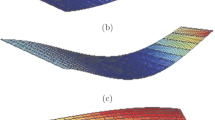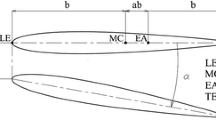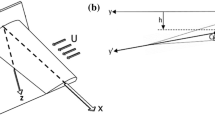Abstract
Shape sensitivities of flutter characteristics can predict the moving of flutter boundary as wing shape varies. The nonlinear relationship between mass, stiffness and damping matrices of aeroelastic systems and shape variables makes the flutter characteristics vary nonlinearly as shape variables change. The computation cost of finite difference method is high and it cannot solve precisely shape sensitivities. An analytic method is developed to compute sensitivities of flutter characteristics of low aspect ratio wings to shape parameters, which include aspect ratio, taper ratio, sweep angle, and area. On the basis of the equivalent plate model and piston theory, analytic sensitivities of mass, stiffness and damping matrices with respect to various shape parameters are computed. The equivalent plate model is a continuous aeroelasticity analysis model oriented toward wing design. The flutter equation is solved by tracking the root locus of the system state space model. Lancaster’s adjoint method is used to solve the eigenvalue derivatives and shape sensitivities of flutter characteristics. Linear Taylor approximation based on the analytic sensitivities is used to predict the variation of flutter speed with respect to shape variables. Comparison of these results with those from reanalysis indicates that Taylor approximation based on analytic sensitivities can precisely predict trends of flutter characteristics near the baseline configuration, but the applied neighborhood is small for sweep and area. The method can help designers make a judicious choice of wing shape parameters for preventing flutter in the preliminary design phase of aircraft.
Similar content being viewed by others
References
Wright J R, Cooper J E. Introduction to Aircraft Aeroelasticity and Loads. Chichester: John Wiley & Sons, Ltd., 2007
Lin M H, Sun X X. Integrated design of flexible structure/flutter active control law (in Chinese). Acta Aeron Astron Sin, 2001, 22: 30–34
Liu Y H, Kapania M. Modal response of trapezoidal wing structures using sencond order shape sensitivities. AIAA J, 2000, 38: 732–735
Haftka R T, Gurdal Z. Elements of Structural Optimization. The Netherlands: Kluwer Academic Publishers, 1992. 255–304
Lv B, Tan S G, Yang C. Optimization design for aeroelastic dynamics of T-tail (in Chinese). J Beijing Univ Aeron Astro, 2007, 33: 409–413
Wu Q, Wan Z Q, Yang C. Design optimization of flutter scaled model considering structural dynamic and flutter constraints (in Chinese). Acta Aeron Astron Sin, 2011, 32: 1210–1216
Yang C, Xiao Z P. Aeroelastic optimization design for wing with maneuvor load uncertainties. Sci China Tech Sci, 2010, 53: 3102–3109
Gao P, Guan D. Integrated design of flexible structure/flutter active control law (in Chinese). Acta Aeron Astron Sin, 1995, 16: 521–527
Liu X N, Xiang J W. Study of aeroelastic tailoring of high aspectratio flexible composite wing (in Chinese). Acta Aeron Astron Sin, 2006, 32: 1403–1407
Singhvi S, Kapania R K. Shape sensitivities and approximation of modal response of laminated skew plates. J Aircraf, 1993
Livne E. Analytical sensitivities for shape optimization in equivalent plate structural models. J Aircraf, 1994, 31: 961–969
Livne E, Mineau D. Panel flutter constraints: analytic sensitivities and approximations including planform shape design variables. J Aircraf, 1997, 34: 558–568
Giles G L. Equivalent plate analysis of aircraft wing box structures with general planform geometry. J Aircraf, 1986, 23: 859–864
Livne E. Equivalent plate structural modeling for wing shape optimization including transverse shear. AIAA J, 1994, 32: 1278–1288
Yang Y X, Wu Z G, Yang C. Flutter analyses of missile wing using equivalent plate model (in Chinese). Acta Aeron Astron Sin, 2011, 32: 833–840
Yang Y X, Wu Z G, Yang C, et al. An aeroelasticity analysis model oriented toward wing design (in Chinese). Acta Aeron Astron Sin, 2011, 32: 1860–1868
Chen G B, Zou C Q, Yang C. Elements of Aeroelastic Dynamics (in Chinese). Beijing: Beijing University of Aeronautics and Astronautics Press, 2004
Reissner E. The effect of transverse shear deformation on the bending of elastic plates. J Apppl Mech, 1945, 12: A69–A77
Mindlin R D. Influence of rotatory interia and shear on flexural motions of isotropic, elastic plates. J Appl Mach, 1951, 18: 31–38
Murthy D V, Haftka R T. Survey of methods for calculating sensitivity of general eigenproblems. NASA CP-2457, 1987
H. M W G H. The aerodynamic effects of aspect ratio and sweepback on wing flutter. ARC R&M 3011, 1955
Author information
Authors and Affiliations
Corresponding author
Rights and permissions
About this article
Cite this article
Yang, C., Yang, Y. & Wu, Z. Shape sensitivity analysis of flutter characteristics of a low aspect ratio supersonic wing using analytical method. Sci. China Technol. Sci. 55, 3370–3377 (2012). https://doi.org/10.1007/s11431-012-4933-3
Received:
Accepted:
Published:
Issue Date:
DOI: https://doi.org/10.1007/s11431-012-4933-3




